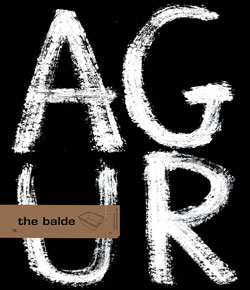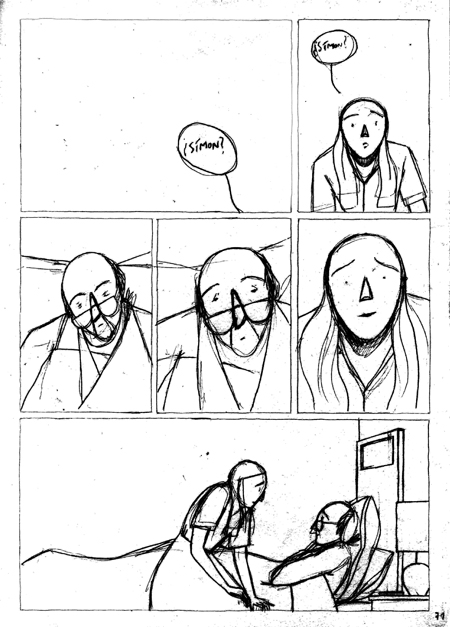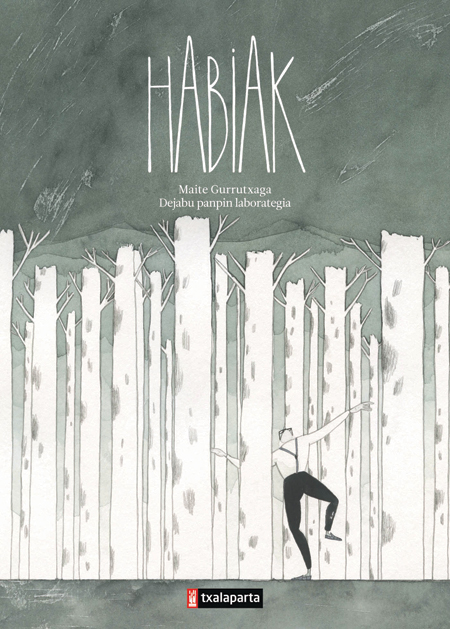nests
Theatre group Dejabu picked the grass shoots in Bosnia and illustrator Maite Gurrutxaga weaved them together to form Habiak (Nests). The decision by the authors to publish their collaborative work in the form of a comic proves that there are still new artistic routes available to be explored. Dejabu
In Deja Bu you principally work in theatre and with puppets. How did this story come about and where did the idea for the comic come from?
In the Deja Bu Puppet Workshop we always try to create fictional stories based on experiences close to us. Before we came up with the story we had been to Bosnia three times from 2002 to 2005, especially in Gorazde, where we had been invited by SOS Balkanes. The experience was both beautiful and tough in equal measure. We were quite young at the time and we were given the opportunity to feel the consequences of a genocide first hand. We were really affected by that experience. We then spent a few years London studying theatre, and that was where we first felt homesick. Ainara’s farmer grandfather died while we were there… and it’s now we realise that the play came out of all of those experiences. We felt the need to express our feelings, our anger.
So, we wrote the play Gizona ez da txoria (Man is not a bird) in 2007 as a short theatre piece, and in 2009 we developed it into a full play. We wanted to work on the relationship between acting and puppetry because we wanted to see what new language this would create/ demand. It was great. Truth be told, we are always looking for our own form of expression, and we sometimes mix different theatre langauges, on purpose, you know, to try and surprise ourselves. We don’t like the rigid lines that mark expression in art, those stuffy compartments and labels handed out: theatre, children’s theatre, circus, puppetry, contemporary dance… the best thing is to use them all, or at least any of them that further what you want to do. The same reasoning is behind this comic… drawings that came from a play… Why not? It is true that our theatre work is quite aesthetic and heavily based on movement so we first thought it wouldn’t be possible to get that down on paper. We have recently been reading a lot of graphic novels, and it just came to us like a bang, and we got the idea to do one ourselves.
We were already familiar with Maite’s work as an illustrator and we asked her if she would like to do a comic with us. To our surprise she said yes and she was involved with us with the script from the beginning. To be honest, the biggest challenge for us was the time needed for the drawings and the detail. It was also a new ‘language’ for Maite and us. Maite took responsibility for the whole process of drawing and adapting the script, and she has done stellar work, really! It has been an incredible experience.
Maite Gurrutxaga
What kind of a challenge was it to adapt Deja-Bu’s theatre play to the comic book format?
Well, it certainly was a big challenge. I think that when you get involved in something like this, you have to believe in the work you have before you. You have to make it yours, you know, really commit to the work at hand. That was the first thing I had to do when I received the commission, I had to like the work and be willing to make a big effort to make that happen. I got the script and the play, and after reading and seeing the Deja Bu Puppet Theatre, I said yes, I wanted to become a part of the project. I knew it was going to be a huge undertaking but I took up the challenge and decided to give it the time it would need. I say challenge because at the beginning the idea was to design, set the layout, publish and do everything for the book ourselves.
We would even look after distribution too if necessary. However, in the end publishers Txalaparta, and with them Monti, came on board and we’re really pleased with their contribution, they have really helped out a lot. One of the most demanding elements, and at the same time, one of the most enjoyable, has been the task of adapting the script of the play to the language of comics. It brings it to a completely different level altogether. That’s why I was able to work and experiment on different new approaches and work methods. I was able to work on parallel stories while I was creating the storyboard that would help bring the comic about.
There is a difference between illustrating and creating a comic… What has that change been like?
Yes, there certainly is a difference between illustration and creating a comic book story, but I would say they are part of the same family because a pictured narrative is created in both of them. Both of them aim to narrate. The biggest difference I have found is that a story must be developed sequentially in a comic. It reminds me of cinema. In illustration, an idea, or many ideas, must be developed in a single picture. I really like both of them, you know, creating a whole world in a single scene or developing that world through a long series of different scenes.
In Deja Bu you principally work in theatre and with puppets. How did this story come about and where did the idea for the comic come from?
In the Deja Bu Puppet Workshop we always try to create fictional stories based on experiences close to us. Before we came up with the story we had been to Bosnia three times from 2002 to 2005, especially in Gorazde, where we had been invited by SOS Balkanes. The experience was both beautiful and tough in equal measure. We were quite young at the time and we were given the opportunity to feel the consequences of a genocide first hand. We were really affected by that experience. We then spent a few years London studying theatre, and that was where we first felt homesick. Ainara’s farmer grandfather died while we were there… and it’s now we realise that the play came out of all of those experiences. We felt the need to express our feelings, our anger.
So, we wrote the play Gizona ez da txoria (Man is not a bird) in 2007 as a short theatre piece, and in 2009 we developed it into a full play. We wanted to work on the relationship between acting and puppetry because we wanted to see what new language this would create/ demand. It was great. Truth be told, we are always looking for our own form of expression, and we sometimes mix different theatre langauges, on purpose, you know, to try and surprise ourselves. We don’t like the rigid lines that mark expression in art, those stuffy compartments and labels handed out: theatre, children’s theatre, circus, puppetry, contemporary dance… the best thing is to use them all, or at least any of them that further what you want to do. The same reasoning is behind this comic… drawings that came from a play… Why not? It is true that our theatre work is quite aesthetic and heavily based on movement so we first thought it wouldn’t be possible to get that down on paper. We have recently been reading a lot of graphic novels, and it just came to us like a bang, and we got the idea to do one ourselves.
We were already familiar with Maite’s work as an illustrator and we asked her if she would like to do a comic with us. To our surprise she said yes and she was involved with us with the script from the beginning. To be honest, the biggest challenge for us was the time needed for the drawings and the detail. It was also a new ‘language’ for Maite and us. Maite took responsibility for the whole process of drawing and adapting the script, and she has done stellar work, really! It has been an incredible experience.
Maite Gurrutxaga
What kind of a challenge was it to adapt Deja-Bu’s theatre play to the comic book format?
Well, it certainly was a big challenge. I think that when you get involved in something like this, you have to believe in the work you have before you. You have to make it yours, you know, really commit to the work at hand. That was the first thing I had to do when I received the commission, I had to like the work and be willing to make a big effort to make that happen. I got the script and the play, and after reading and seeing the Deja Bu Puppet Theatre, I said yes, I wanted to become a part of the project. I knew it was going to be a huge undertaking but I took up the challenge and decided to give it the time it would need. I say challenge because at the beginning the idea was to design, set the layout, publish and do everything for the book ourselves.
We would even look after distribution too if necessary. However, in the end publishers Txalaparta, and with them Monti, came on board and we’re really pleased with their contribution, they have really helped out a lot. One of the most demanding elements, and at the same time, one of the most enjoyable, has been the task of adapting the script of the play to the language of comics. It brings it to a completely different level altogether. That’s why I was able to work and experiment on different new approaches and work methods. I was able to work on parallel stories while I was creating the storyboard that would help bring the comic about.
There is a difference between illustrating and creating a comic… What has that change been like?
Yes, there certainly is a difference between illustration and creating a comic book story, but I would say they are part of the same family because a pictured narrative is created in both of them. Both of them aim to narrate. The biggest difference I have found is that a story must be developed sequentially in a comic. It reminds me of cinema. In illustration, an idea, or many ideas, must be developed in a single picture. I really like both of them, you know, creating a whole world in a single scene or developing that world through a long series of different scenes.




